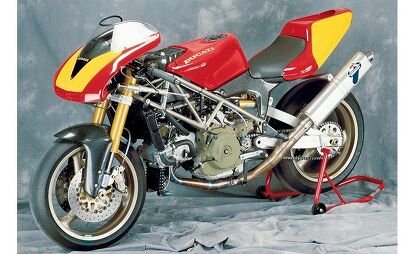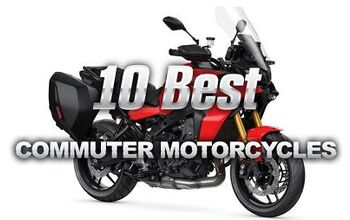Falloon Files: 1993 Ducati Supermono
Doppio Bielletta is not a coffee
Hey! I got to ride one of those once. My old 608cc Yamaha SRX-6 singles racer was built not quite to the hilt and made 52 horsepower. The Ducati Supermono made more like 70 hp from 502cc, and was about a 3/4-scale model of the Yamaha.
Ian Falloon may be the greatest writer of motorcycle books ever. Lately he’s taken to excerpting some of his work on Facebook, which is where we stumbled across this tidbit from his 2014 tome, The Art of the Ducati.
Over Ducati’s history there have been many unfulfilled promises, but none more squandered than the Supermono. Ducati’s tradition was founded on single-cylinder motorcycles, and when the Supermono was conceived it promised to resurrect the concept, forming the foundation of a new family of high technology single-cylinder machines.
Championed by Massimo Bordi, Ducati’s then engineering chief envisaged the Supermono as the perfect single-cylinder motorcycle for both the racetrack and street. Although the Supermono project began after the 916, the Supermono prototype was unveiled a year earlier, at the Cologne Show, at the end of 1992. It caused a sensation, and remains one of the most beautiful and timeless of all Ducati designs. The Supermono was a catalog racer produced by the racing department, and intended for “Sound of Singles” racing, much the same as the 888 Racing.
The heart of the Supermono was the engine, development of which began during 1990. Bordi elected to adapt the 90-degree V-twin so that vibration, the traditional bugbear of big singles, could be eliminated. Bordi’s original idea called for a V-twin with a dummy piston, but due to internal friction and crankcase pressure, the 487cc engine produced a disappointing 53 horsepower on its first dyno run. An increase to 57 horsepower was also deemed insufficient.
Bordi then incorporated a unique counterbalancing system, attaching a second con-rod to a lever pivoting on a pin fixed in the crankcase. Called doppia bielletta (double con-rod), it was the first time this system had been used in a petrol engine, although it had previously featured on diesel engines. Bordi had considerable experience with small direct-injection diesels, as he was involved with VM diesel development at Ducati from 1978 until he started working on motorcycle engines in 1982.
The revised Supermono engine was more compact than the earlier design, and it replicated the twin’s perfect primary balance without the burden of the dummy piston’s friction. Power rose immediately to 62.5 horsepower at 10,500 rpm. The next development stage saw a 502cc version (95.6×70 mm) that produced 70 horsepower.
The development team, led by Gianluigi Mengoli and Claudio Domenicali, then created a larger cylinder with a wider stud pattern. This allowed a 100mm cylinder and a British Omega 11.8:1 piston. This 549cc version produced 75 horsepower at 10,000 rpm and went into limited production during 1993. Even at 10,000rpm the large single was as smooth as a twin. It was a brilliant concept, both in design and execution.
Many of the Supermono’s features were inherited from the 888 Racing, including liquid-cooling, the double overhead-camshaft four-valve desmodromic cylinder head, and an identical Weber I.A.W. Alfa/N fuel injection system with twin injectors. Throttle body diameter tapered from 50mm to 47mm at the butterfly. The valve sizes were 37 and 31mm, and the camshafts used the same profile as the 926cc 1994 888 Racing.
There were some important departures in the engine design, notably the use of much stronger 49mm plain main bearings, a dry 180-watt alternator, and the water pump driven off the exhaust camshaft. Many other engine components were specific to the Supermono, including the crankcases, cylinders, crankshaft, and gearbox. As with the 888 Racing, the two Pankl con rods were titanium. The 50mm exhaust exited on the right into either a Termignoni single or dual-outlet muffler.
Housing this remarkable engine was a TIG-welded tubular steel frame built by Cagiva Telai in Varese, with an aluminum Verlicchi-made swingarm. Each frame was individually crafted, and was intended only for limited production. The 916 frame appeared crude by comparison. The Supermono’s rear suspension was by cantilever, but with a nine percent rising rate due to the mounting angle. Only the highest quality suspension components were fitted: a 42mm Öhlins inverted fork with magnesium triple clamps up front and a ride-height adjustable Öhlins shock absorber out back.
A steering head angle of 23 degrees and a compact wheelbase of 1,360mm (53.5 inches) assured responsive handling. Even more significant than the chassis dimensions was the weight distribution, which placed 54.5 percent of the bike’s weight on the front wheel. Brembo brakes and 17-inch magnesium Marchesini wheels were full race spec.
When the Supermono debuted it wore stunning, full carbon-fiber bodywork that had been designed by Pierre Terblanche in just two months. The Supermono finally went into production during 1993, built solely as a Sounds of Singles racer by the racing department. Only 30 were manufactured that year, plus a further 10 in 1994.
The Supermono suffered up to a 50 percent deficit in capacity compared to some of the specialized single-cylinder racers it competed against. In fine Ducati tradition, it relied on finesse and balance to achieve success. A larger version was created for 1995, its 102mm piston yielding 572cc. Updates included a revised EPROM and silencer, and a new 42mm Öhlins front fork and longer shock absorber. Even this capacity increase wasn’t enough to ensure racetrack dominance, and after only 25 further examples were built, that was the end of the Supermono. (A Supermono engine was placed in a 900 SS frame in 1998 with a view to implementing production, but nothing came of the exercise.)
Apart from the ability to rev smoothly to previously unheard of levels for a big single, much of the Supermono’s exceptional ability was due to its remarkably low center of gravity. Perfectly balanced and proportioned, the Supermono offered everything: stability, agility, quick steering, and amazing response. It’s a shame such a wonderful machine never made it to regular production.
Shop for the Art of the Ducati here
We are committed to finding, researching, and recommending the best products. We earn commissions from purchases you make using the retail links in our product reviews. Learn more about how this works.
Become a Motorcycle.com insider. Get the latest motorcycle news first by subscribing to our newsletter here.
More by John Burns



































Comments
Join the conversation
I saw one of these in person back in the day at Laguna Seca. I still regard it as one of the coolest motorcycles I’ve ever seen. Sure wish these had made it into wider production.
Cf. Husqvarna 701 Pilens. Or their Supermoto